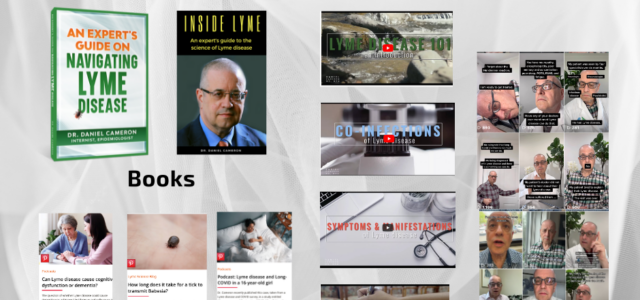Lyme Science Blog
Dr. Daniel Cameron, MD, MPH, is a nationally recognized leader for his expertise in the diagnosis and treatment of Lyme disease and other tick-borne illnesses. His weekly Lyme Disease Science blog features articles covering the latest research, insights and case reviews.
Lyme Science Blog
Does Lyme disease affect the brain?
In their article entitled “Common Neurologic Features of Lyme Disease That May Present to a Rheumatologist,” Govil et al. describe
Lyme Science Blog
Lyme disease or dementia?
The authors describe a case in which an elderly man with dementia was referred to an Alzheimer’s Disease Care Unit
Lyme Science Blog
Abnormal MRI leads to Lyme encephalitis diagnosis
In their article “Lyme neuroborreliosis with encephalitis: A rare case,” Rosendahl and colleagues describe a 74-year-old immunocompromised woman, who was
Lyme Science Blog
Is SOT an effective treatment for Lyme disease?
In their article “Supportive Oligonucleotide Therapy (SOT) as a Potential Treatment for Viral Infections and Lyme Disease: Preliminary Results,” Apostolou
Lyme Science Blog
Borrelia miyamotoi infection: An emerging tick-borne disease in California
“Although B. miyamotoi has been identified in ticks in California for more than 20 years, locally acquired human cases within
Lyme Science Blog
Dr. Cameron’s Lyme disease toolbox
Two Cases Profiles in Lyme disease – Sophie Profiles in Lyme disease – Ira 17 minute introduction to Lyme disease
Lyme Science Blog
Tick control methods not effective in residential neighborhoods
In their study, “Impacts Over Time of Neighborhood-Scale Interventions to Control Ticks and Tick-Borne Disease Incidence,” Ostfeld and colleagues examined
Lyme Science Blog
Lyme carditis patients may require temporary permanent pacemaker
However, the authors of a new case report suggest that for some Lyme carditis patients, placement of a temporary permanent
Lyme Science Blog
Can skin color affect medical students’ ability to diagnose Lyme disease?
So, how prepared are medical students to properly diagnose patients of all races and ethnicities? Do they have the diagnostic









